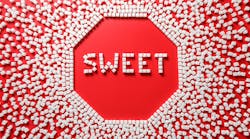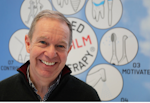Close your eyes and imagine for a moment a world without sugar. What would it look like? How would it feel—uncomfortable or amazing?
Sugar is a regular go-to for celebrations, gifts, and treats. When was the last time you consumed sugar? Weeks, days, or a few hours ago? But think about it: surely the definition of a “treat” is something out of the ordinary, something that gives pleasure, and not something to be consumed on a regular basis.
Sugar statistics
In the last 200 years, sugar consumption for the average person has gone from 2 kg per year or roughly one teaspoon per day to well over 28 kg per year—20 teaspoons per day.1 In 2021–2022, total sugar consumption in the US was 11.3 million metric tons.2 This number increases every year, and more than half of these sugars are in ultraprocessed foods.3
The US obesity prevalence is 42% for adults and 20% for children,4 and nearly 9% of the US population has been diagnosed with diabetes.4,5 The prevalence of dental caries is 23% in children two to five years old, 52% in children six to eight years old, 57% in adolescents 12 to 19 years old, and 90% in adults.6
Some research on sugar
Sugar, although widely enjoyed by dental professionals, tends to come up with patients as something to be avoided. This contradictory behavior may be one of the reasons that the dental profession has been so unsuccessful in persuading patients to stop consuming so much sugar.
I thought asking a group of dental professionals to attempt reducing sugar as they were asking their patients to do would provide an opportunity for them to create a new knowledge base. Back in 2020, this was the start of a research journey that led to two published papers and is still ongoing.
You may also be interested in ... Sugar consumption: Damaging more than just teeth
In my first published research, I discovered that dental hygienists and dental therapists struggled to stop eating sugar for a variety of reasons.7 Many were unaware of the new and different names for sugar found in a list of ingredients. Are you familiar with diastase or diastatic malt? There are now more than 60 different names for sugar, so despite attempts at clearer food labeling, the sugar industry will still find a way to confuse shoppers, including health-care professionals.
The dental professionals I studied also did not expect how much stress, boredom, and various emotions would prevent them from eating a no-added-sugar diet. The biggest surprise for many was that they were addicted to sugar and were subsequently unable to kick the habit. Those who were addicted and succeeded had to suffer many days of uncomfortable side effects. One of the biggest outcomes was that all research participants, having experienced an attempt to stop consuming sugar, indicated they would change their approach to dietary counseling and patient behavior change.7
It takes a … tribe
In this research, one of the participants started a Facebook support group. Interestingly, hygienists and therapists who joined the group were more likely to be successful in quitting sugar. After several months of researching why this happened, I came across the power of tribal behavior, which is embedded deep within the human psyche. In ancient tribes, the threat of being removed from the group would be life-threatening. This ancient belief system is more powerful than addictive behavior.8 Essentially, tribal behavior trumps addiction.
With the same research participants, I created a “no-added-sugar tribe.”9 For three months, the group was asked to join weekly online video meetings to provide emotional and mental support to one another regarding the avoidance of added sugar. The results were amazing. Most participants lost weight and were happier and far healthier both mentally and physically—so much so that they didn’t want the research to end.9 At their request, I kept the no-added-sugar tribe group open on Facebook, and gradually more and more hygienists requested to join. I now have more than 200 clinicians asking for support to quit sugar!
Recommendations
Based on the new knowledge created by our tribe, here are my recommendations.
- All those with a role to play in advising patients on dietary health should attempt to stop consuming added sugar. The knowledge gained from this experience, whether successful or not, will benefit their approach to change in health behavior.
- As a profession, we all need more training and support in the diagnosis, assessment, and recovery of sugar and processed food addiction.
- We need to engender a change in mindset about sugar among all staff.
- We should make it clear to our staff and patients that sugar is extremely dangerous to health, and then open a dialogue about sugar addiction.
- We need to make clear, unambiguous up-to-date information regarding everything related to sugar available to the dental team and the public.
- Given the success of the “tribe,” we should investigate the possibility of creating and developing practice-supported groups for patients who need guidance about sugar addiction and cessation.
Now, close your eyes and imagine a world without sugar.
Editor's note:This article appeared in the June 2023 print edition of RDH magazine. Dental hygienists in North America are eligible for a complimentary print subscription. Sign up here.References
- How much sugar is too much? American Heart Association. Accessed January 2023. https://www.heart.org/en/healthy-living/healthy-eating/eat-smart/sugar/how-much-sugar-is-too-much
- Shahbandeh M. Sugar consumption in the United States from 2010/2011 to 2021/2022 (in million metric tons). Statista. June 10, 2022. Accessed January 2023. https://www.statista.com/statistics/249692/us-sugar-consumption/
- Rauber F, da Costa Louzada ML, Steele EM, et al. Ultra-processed foods and excessive free sugar intake in the UK: a nationally representative cross-sectional study. BMJ Open. 2019;9(10):e027546. doi:10.1136/bmjopen-2018-027546
- Adult obesity facts. Centers for Disease Control and Prevention. Division of Nutrition, Physical Activity, and Obesity. National Center for Chronic Disease Prevention and Health Promotion. Updated May 17, 2022. Accessed January 2023. https://www.cdc.gov/obesity/data/adult.html
- Prevalence of diagnosed diabetes. Centers for Disease Control and Prevention. Updated September 30, 2022. Accessed January 2023. https://www.cdc.gov/diabetes/data/statistics-report/diagnosed-diabetes.html
- Oral Health Surveillance Report, 2019. Centers for Disease Control and Prevention. Division of Oral Health. National Center for Chronic Disease Prevention and Health Promotion. 2019. Updated December 9, 2021. Accessed January 2023. https://www.cdc.gov/oralhealth/publications/OHSR-2019-index.html
- Ives T. An investigation into what dental hygienists and dental therapists would discover if they attempted to stop consuming added sugar for 28 days. Ann Clin J Dent Health. 2021;10:11-15.
- Ifland J, Marcus MT, Preuss HG, eds. Processed Food Addiction: Foundations, Assessment, and Recovery. CRC Press; 2020.
- Ives T. An investigation into knowledge gained by a group of dental hygienists and dental therapists invited to join a “no-added-sugar tribe.” Ann Clin J Dent Health. 2022;11:50-55.







